1997 SSANGYONG KORANDO lock
[x] Cancel search: lockPage 1157 of 2053
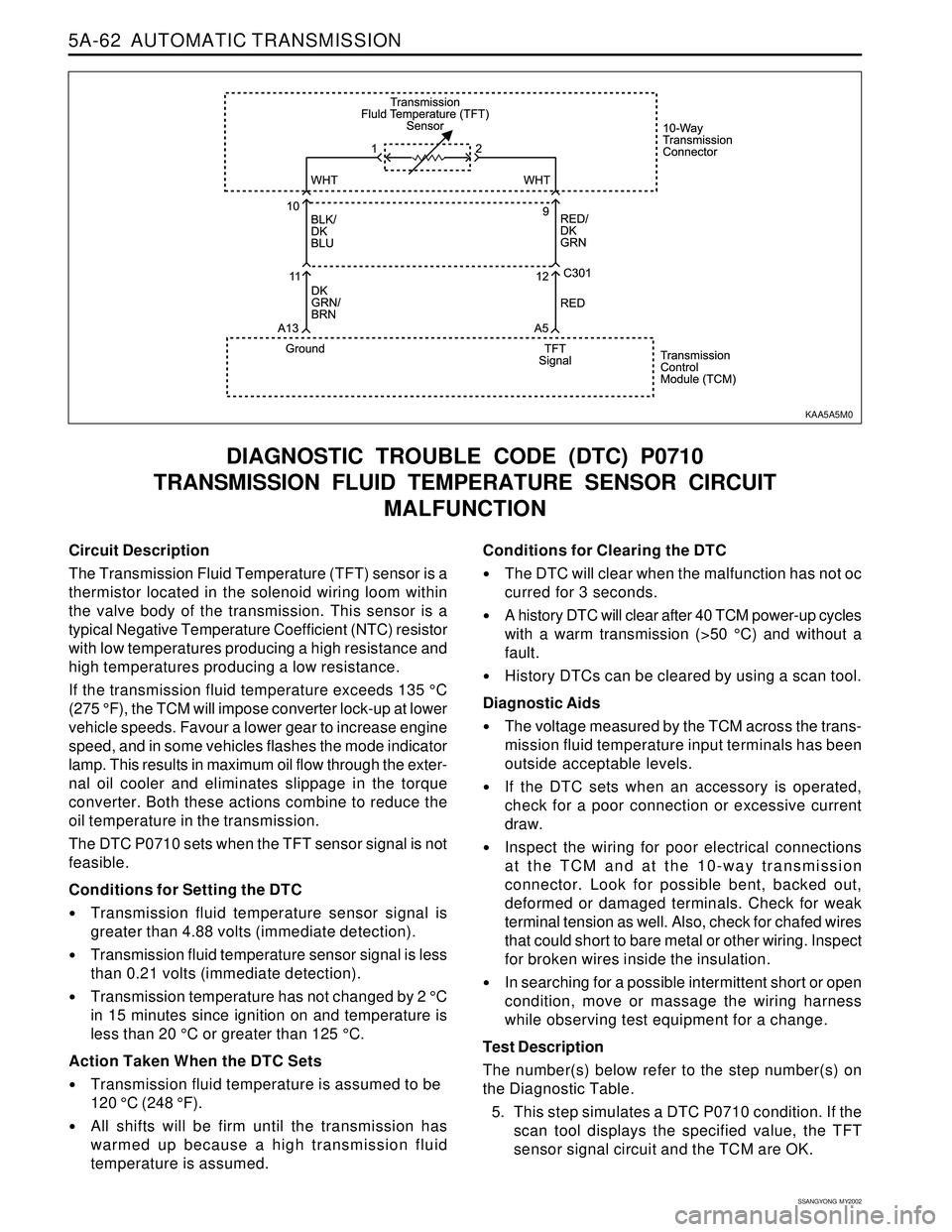
5A-62 AUTOMATIC TRANSMISSION
SSANGYONG MY2002
Circuit Description
The Transmission Fluid Temperature (TFT) sensor is a
thermistor located in the solenoid wiring loom within
the valve body of the transmission. This sensor is a
typical Negative Temperature Coefficient (NTC) resistor
with low temperatures producing a high resistance and
high temperatures producing a low resistance.
If the transmission fluid temperature exceeds 135 °C
(275 °F), the TCM will impose converter lock-up at lower
vehicle speeds. Favour a lower gear to increase engine
speed, and in some vehicles flashes the mode indicator
lamp. This results in maximum oil flow through the exter-
nal oil cooler and eliminates slippage in the torque
converter. Both these actions combine to reduce the
oil temperature in the transmission.
The DTC P0710 sets when the TFT sensor signal is not
feasible.
Conditions for Setting the DTC
Transmission fluid temperature sensor signal is
greater than 4.88 volts (immediate detection).
Transmission fluid temperature sensor signal is less
than 0.21 volts (immediate detection).
Transmission temperature has not changed by 2 °C
in 15 minutes since ignition on and temperature is
less than 20 °C or greater than 125 °C.
Action Taken When the DTC Sets
Transmission fluid temperature is assumed to be
120 °C (248 °F).
All shifts will be firm until the transmission has
warmed up because a high transmission fluid
temperature is assumed.
DIAGNOSTIC TROUBLE CODE (DTC) P0710
TRANSMISSION FLUID TEMPERATURE SENSOR CIRCUIT
MALFUNCTION
Conditions for Clearing the DTC
The DTC will clear when the malfunction has not oc
curred for 3 seconds.
A history DTC will clear after 40 TCM power-up cycles
with a warm transmission (>50 °C) and without a
fault.
History DTCs can be cleared by using a scan tool.
Diagnostic Aids
The voltage measured by the TCM across the trans-
mission fluid temperature input terminals has been
outside acceptable levels.
If the DTC sets when an accessory is operated,
check for a poor connection or excessive current
draw.
Inspect the wiring for poor electrical connections
at the TCM and at the 10-way transmission
connector. Look for possible bent, backed out,
deformed or damaged terminals. Check for weak
terminal tension as well. Also, check for chafed wires
that could short to bare metal or other wiring. Inspect
for broken wires inside the insulation.
In searching for a possible intermittent short or open
condition, move or massage the wiring harness
while observing test equipment for a change.
Test Description
The number(s) below refer to the step number(s) on
the Diagnostic Table.
5. This step simulates a DTC P0710 condition. If the
scan tool displays the specified value, the TFT
sensor signal circuit and the TCM are OK.
KAA5A5M0
Page 1167 of 2053
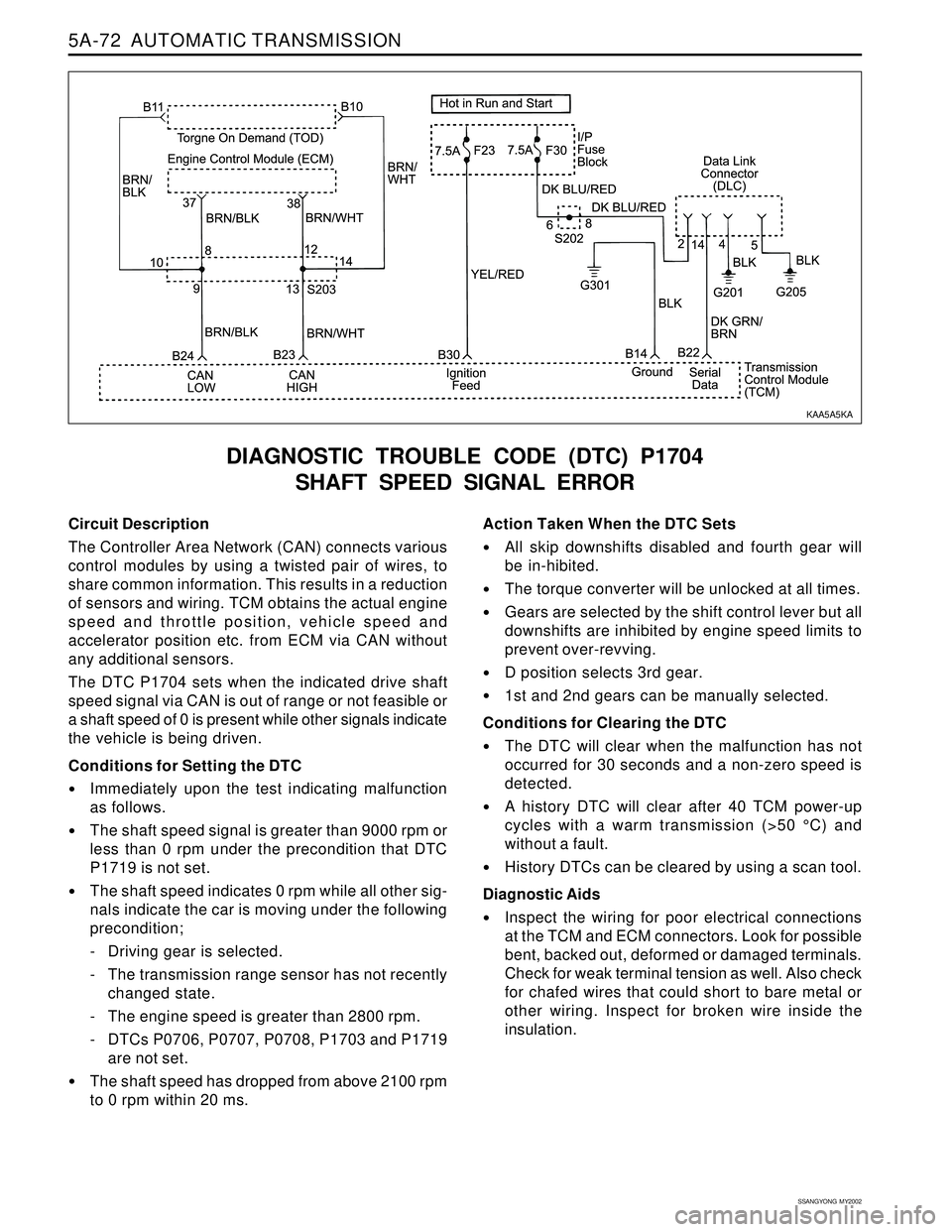
5A-72 AUTOMATIC TRANSMISSION
SSANGYONG MY2002
Circuit Description
The Controller Area Network (CAN) connects various
control modules by using a twisted pair of wires, to
share common information. This results in a reduction
of sensors and wiring. TCM obtains the actual engine
speed and throttle position, vehicle speed and
accelerator position etc. from ECM via CAN without
any additional sensors.
The DTC P1704 sets when the indicated drive shaft
speed signal via CAN is out of range or not feasible or
a shaft speed of 0 is present while other signals indicate
the vehicle is being driven.
Conditions for Setting the DTC
Immediately upon the test indicating malfunction
as follows.
The shaft speed signal is greater than 9000 rpm or
less than 0 rpm under the precondition that DTC
P1719 is not set.
The shaft speed indicates 0 rpm while all other sig-
nals indicate the car is moving under the following
precondition;
- Driving gear is selected.
- The transmission range sensor has not recently
changed state.
- The engine speed is greater than 2800 rpm.
- DTCs P0706, P0707, P0708, P1703 and P1719
are not set.
The shaft speed has dropped from above 2100 rpm
to 0 rpm within 20 ms.
DIAGNOSTIC TROUBLE CODE (DTC) P1704
SHAFT SPEED SIGNAL ERROR
Action Taken When the DTC Sets
All skip downshifts disabled and fourth gear will
be in-hibited.
The torque converter will be unlocked at all times.
Gears are selected by the shift control lever but all
downshifts are inhibited by engine speed limits to
prevent over-revving.
D position selects 3rd gear.
1st and 2nd gears can be manually selected.
Conditions for Clearing the DTC
The DTC will clear when the malfunction has not
occurred for 30 seconds and a non-zero speed is
detected.
A history DTC will clear after 40 TCM power-up
cycles with a warm transmission (>50 °C) and
without a fault.
History DTCs can be cleared by using a scan tool.
Diagnostic Aids
Inspect the wiring for poor electrical connections
at the TCM and ECM connectors. Look for possible
bent, backed out, deformed or damaged terminals.
Check for weak terminal tension as well. Also check
for chafed wires that could short to bare metal or
other wiring. Inspect for broken wire inside the
insulation.
KAA5A5KA
Page 1221 of 2053
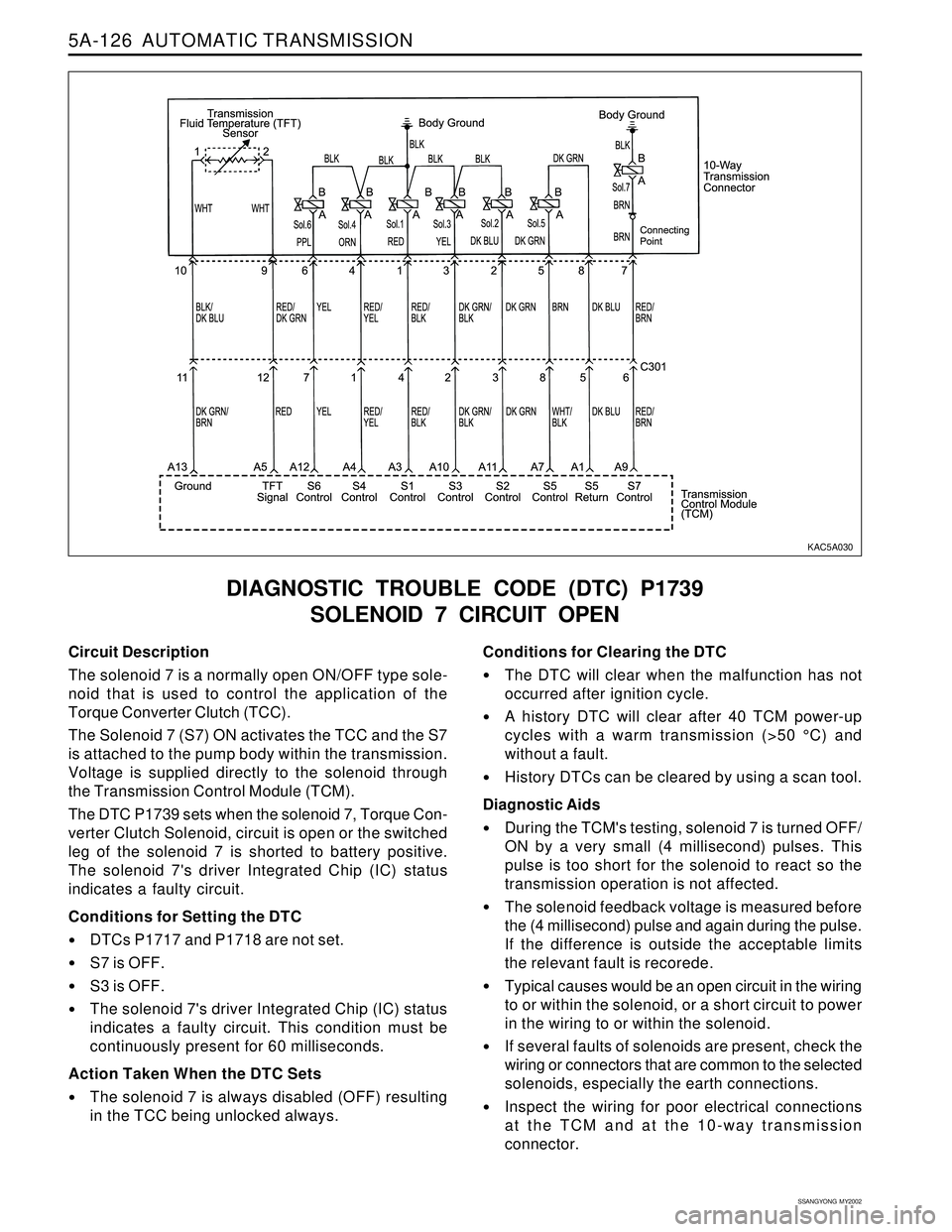
5A-126 AUTOMATIC TRANSMISSION
SSANGYONG MY2002
Circuit Description
The solenoid 7 is a normally open ON/OFF type sole-
noid that is used to control the application of the
Torque Converter Clutch (TCC).
The Solenoid 7 (S7) ON activates the TCC and the S7
is attached to the pump body within the transmission.
Voltage is supplied directly to the solenoid through
the Transmission Control Module (TCM).
The DTC P1739 sets when the solenoid 7, Torque Con-
verter Clutch Solenoid, circuit is open or the switched
leg of the solenoid 7 is shorted to battery positive.
The solenoid 7's driver Integrated Chip (IC) status
indicates a faulty circuit.
Conditions for Setting the DTC
DTCs P1717 and P1718 are not set.
S7 is OFF.
S3 is OFF.
The solenoid 7's driver Integrated Chip (IC) status
indicates a faulty circuit. This condition must be
continuously present for 60 milliseconds.
Action Taken When the DTC Sets
The solenoid 7 is always disabled (OFF) resulting
in the TCC being unlocked always.
DIAGNOSTIC TROUBLE CODE (DTC) P1739
SOLENOID 7 CIRCUIT OPEN
Conditions for Clearing the DTC
The DTC will clear when the malfunction has not
occurred after ignition cycle.
A history DTC will clear after 40 TCM power-up
cycles with a warm transmission (>50 °C) and
without a fault.
History DTCs can be cleared by using a scan tool.
Diagnostic Aids
During the TCM's testing, solenoid 7 is turned OFF/
ON by a very small (4 millisecond) pulses. This
pulse is too short for the solenoid to react so the
transmission operation is not affected.
The solenoid feedback voltage is measured before
the (4 millisecond) pulse and again during the pulse.
If the difference is outside the acceptable limits
the relevant fault is recorede.
Typical causes would be an open circuit in the wiring
to or within the solenoid, or a short circuit to power
in the wiring to or within the solenoid.
If several faults of solenoids are present, check the
wiring or connectors that are common to the selected
solenoids, especially the earth connections.
Inspect the wiring for poor electrical connections
at the TCM and at the 10-way transmission
connector.
KAC5A030
Page 1246 of 2053
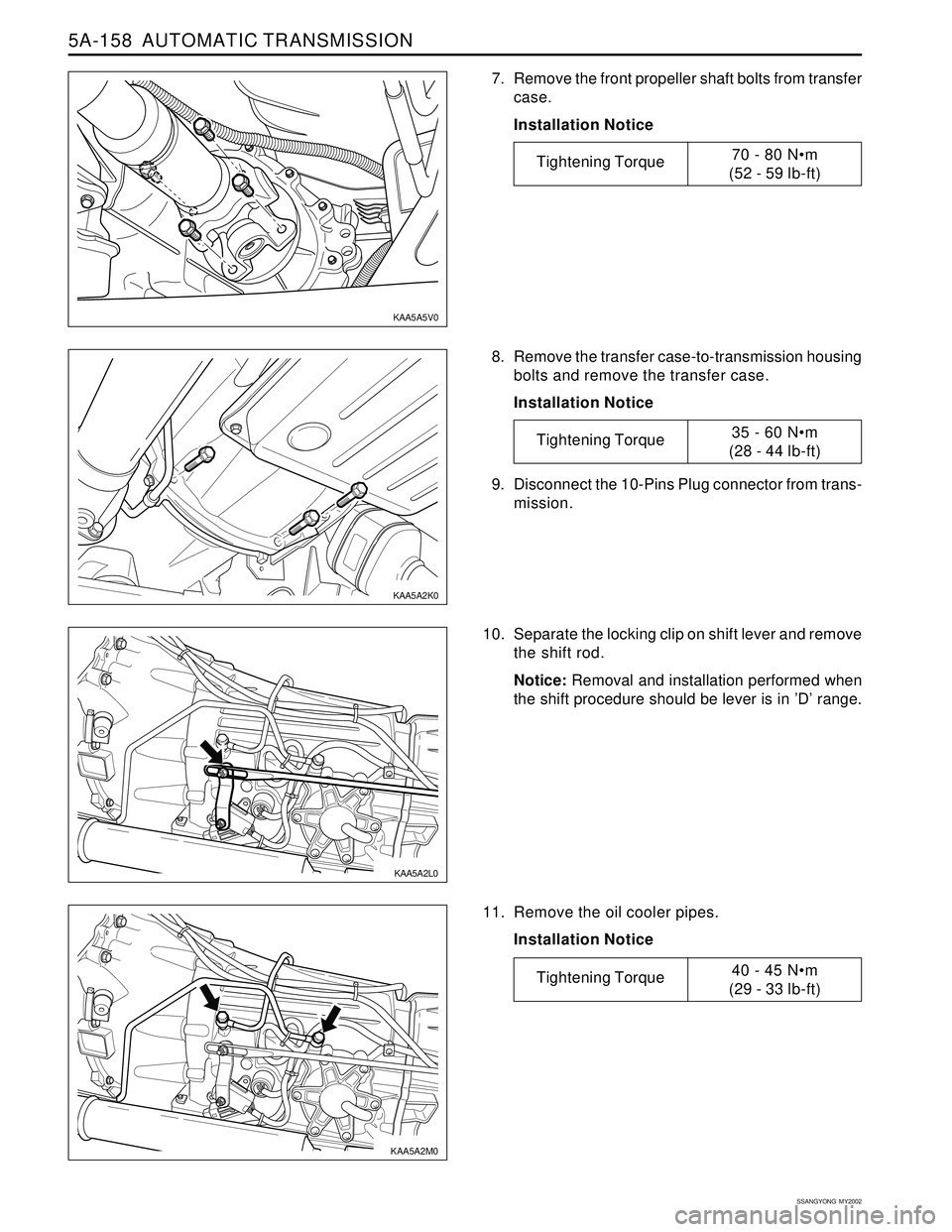
5A-158 AUTOMATIC TRANSMISSION
SSANGYONG MY2002
8. Remove the transfer case-to-transmission housing
bolts and remove the transfer case.
Installation Notice
10. Separate the locking clip on shift lever and remove
the shift rod.
Notice: Removal and installation performed when
the shift procedure should be lever is in ’D’ range.
11. Remove the oil cooler pipes.
Installation Notice 9. Disconnect the 10-Pins Plug connector from trans-
mission.
7. Remove the front propeller shaft bolts from transfer
case.
Installation Notice
KAA5A5V0
KAA5A2K0
KAA5A2L0
KAA5A2M0
Tightening Torque70 - 80 Nm
(52 - 59 lb-ft)
Tightening Torque35 - 60 Nm
(28 - 44 lb-ft)
Tightening Torque40 - 45 Nm
(29 - 33 lb-ft)
Page 1247 of 2053
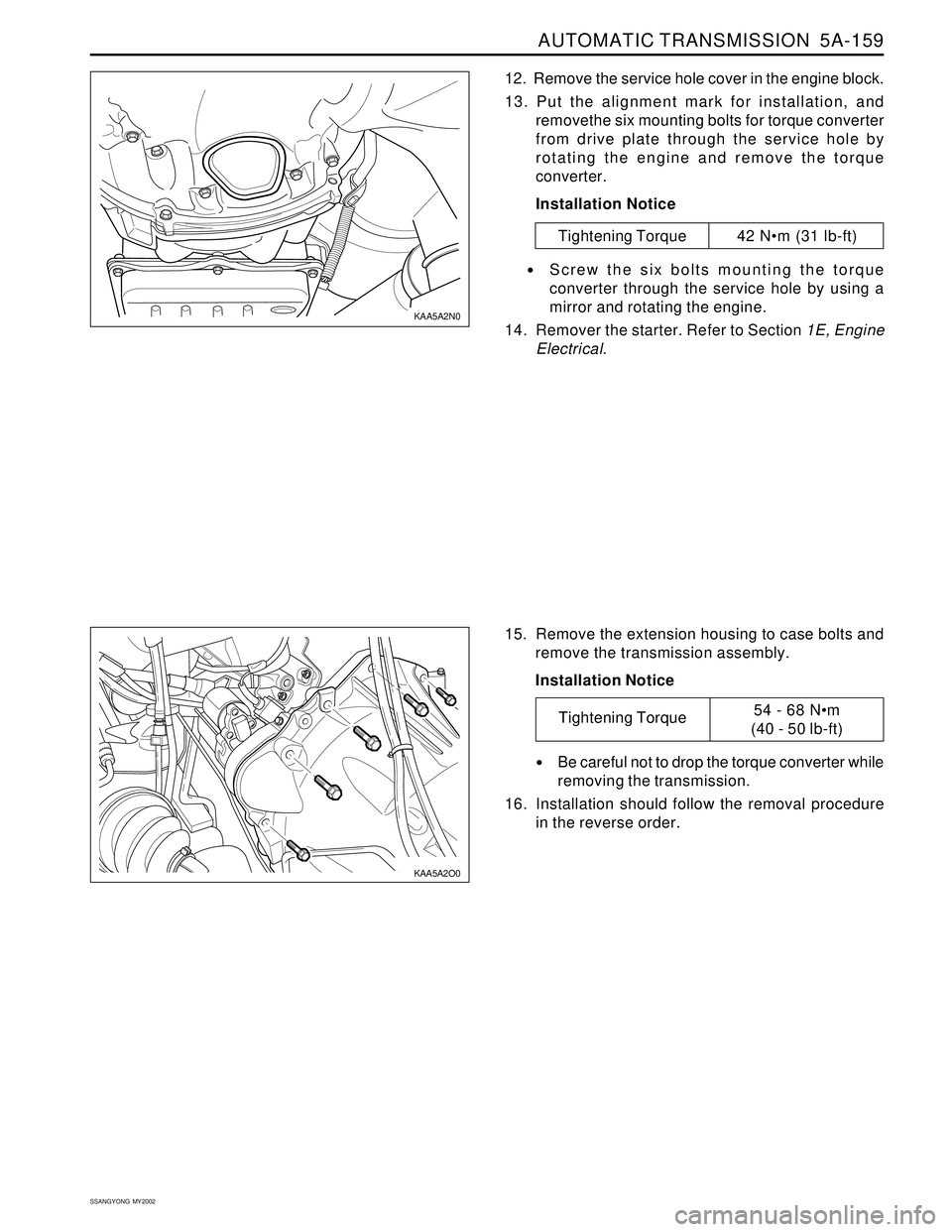
AUTOMATIC TRANSMISSION 5A-159
SSANGYONG MY2002
12. Remove the service hole cover in the engine block.
13. Put the alignment mark for installation, and
removethe six mounting bolts for torque converter
from drive plate through the service hole by
rotating the engine and remove the torque
converter.
Installation Notice
Screw the six bolts mounting the torque
converter through the service hole by using a
mirror and rotating the engine.
14. Remover the starter. Refer to Section 1E, Engine
Electrical.
15. Remove the extension housing to case bolts and
remove the transmission assembly.
Installation Notice
Be careful not to drop the torque converter while
removing the transmission.
16. Installation should follow the removal procedure
in the reverse order.
KAA5A2N0
KAA5A2O0
Tightening Torque54 - 68 Nm
(40 - 50 lb-ft)
Tightening Torque 42 Nm (31 lb-ft)
Page 1252 of 2053
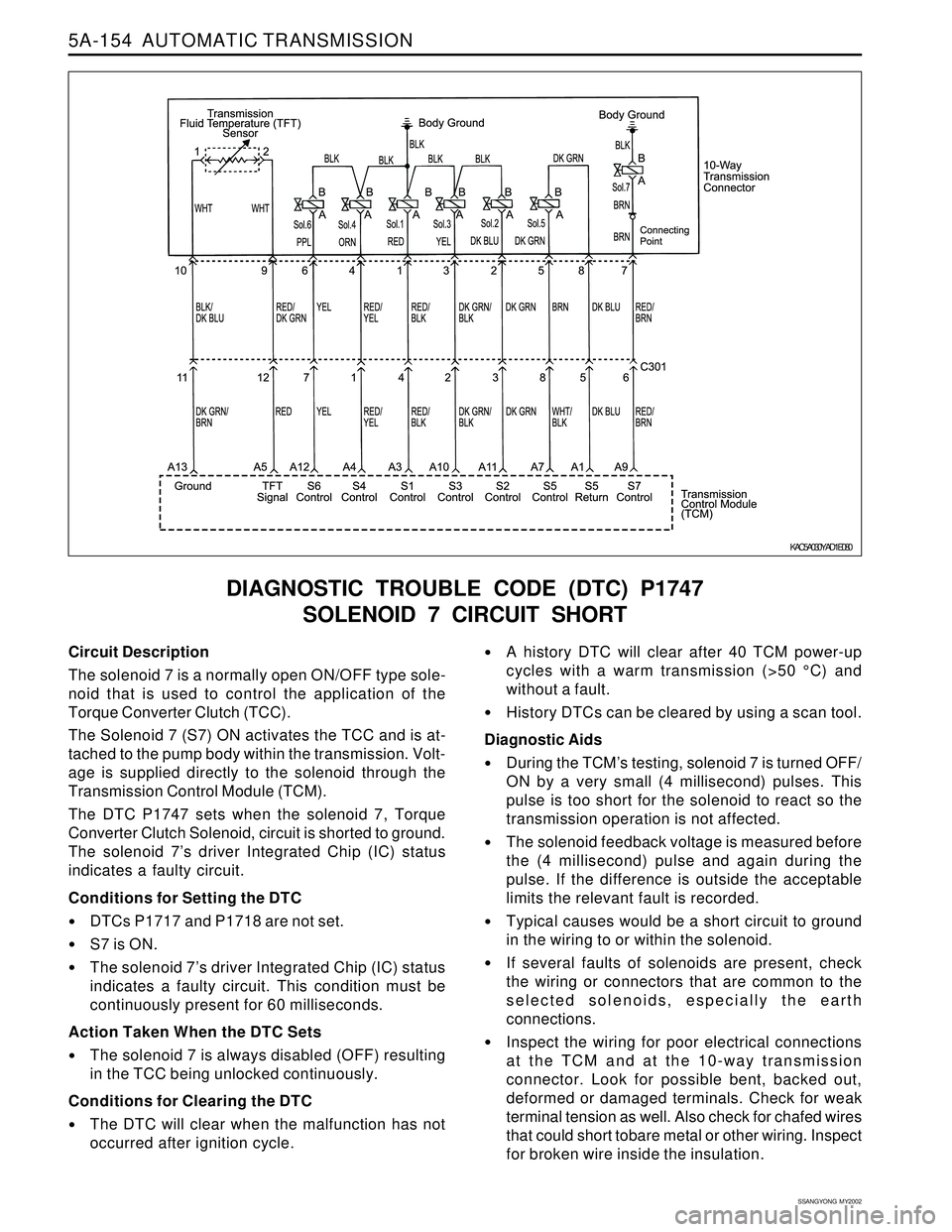
5A-154 AUTOMATIC TRANSMISSION
SSANGYONG MY2002
DIAGNOSTIC TROUBLE CODE (DTC) P1747
SOLENOID 7 CIRCUIT SHORT
Circuit Description
The solenoid 7 is a normally open ON/OFF type sole-
noid that is used to control the application of the
Torque Converter Clutch (TCC).
The Solenoid 7 (S7) ON activates the TCC and is at-
tached to the pump body within the transmission. Volt-
age is supplied directly to the solenoid through the
Transmission Control Module (TCM).
The DTC P1747 sets when the solenoid 7, Torque
Converter Clutch Solenoid, circuit is shorted to ground.
The solenoid 7’s driver Integrated Chip (IC) status
indicates a faulty circuit.
Conditions for Setting the DTC
DTCs P1717 and P1718 are not set.
S7 is ON.
The solenoid 7’s driver Integrated Chip (IC) status
indicates a faulty circuit. This condition must be
continuously present for 60 milliseconds.
Action Taken When the DTC Sets
The solenoid 7 is always disabled (OFF) resulting
in the TCC being unlocked continuously.
Conditions for Clearing the DTC
The DTC will clear when the malfunction has not
occurred after ignition cycle.
A history DTC will clear after 40 TCM power-up
cycles with a warm transmission (>50 °C) and
without a fault.
History DTCs can be cleared by using a scan tool.
Diagnostic Aids
During the TCM’s testing, solenoid 7 is turned OFF/
ON by a very small (4 millisecond) pulses. This
pulse is too short for the solenoid to react so the
transmission operation is not affected.
The solenoid feedback voltage is measured before
the (4 millisecond) pulse and again during the
pulse. If the difference is outside the acceptable
limits the relevant fault is recorded.
Typical causes would be a short circuit to ground
in the wiring to or within the solenoid.
If several faults of solenoids are present, check
the wiring or connectors that are common to the
selected solenoids, especially the earth
connections.
Inspect the wiring for poor electrical connections
at the TCM and at the 10-way transmission
connector. Look for possible bent, backed out,
deformed or damaged terminals. Check for weak
terminal tension as well. Also check for chafed wires
that could short tobare metal or other wiring. Inspect
for broken wire inside the insulation.
KAC5A030YAD1E080
Page 1257 of 2053
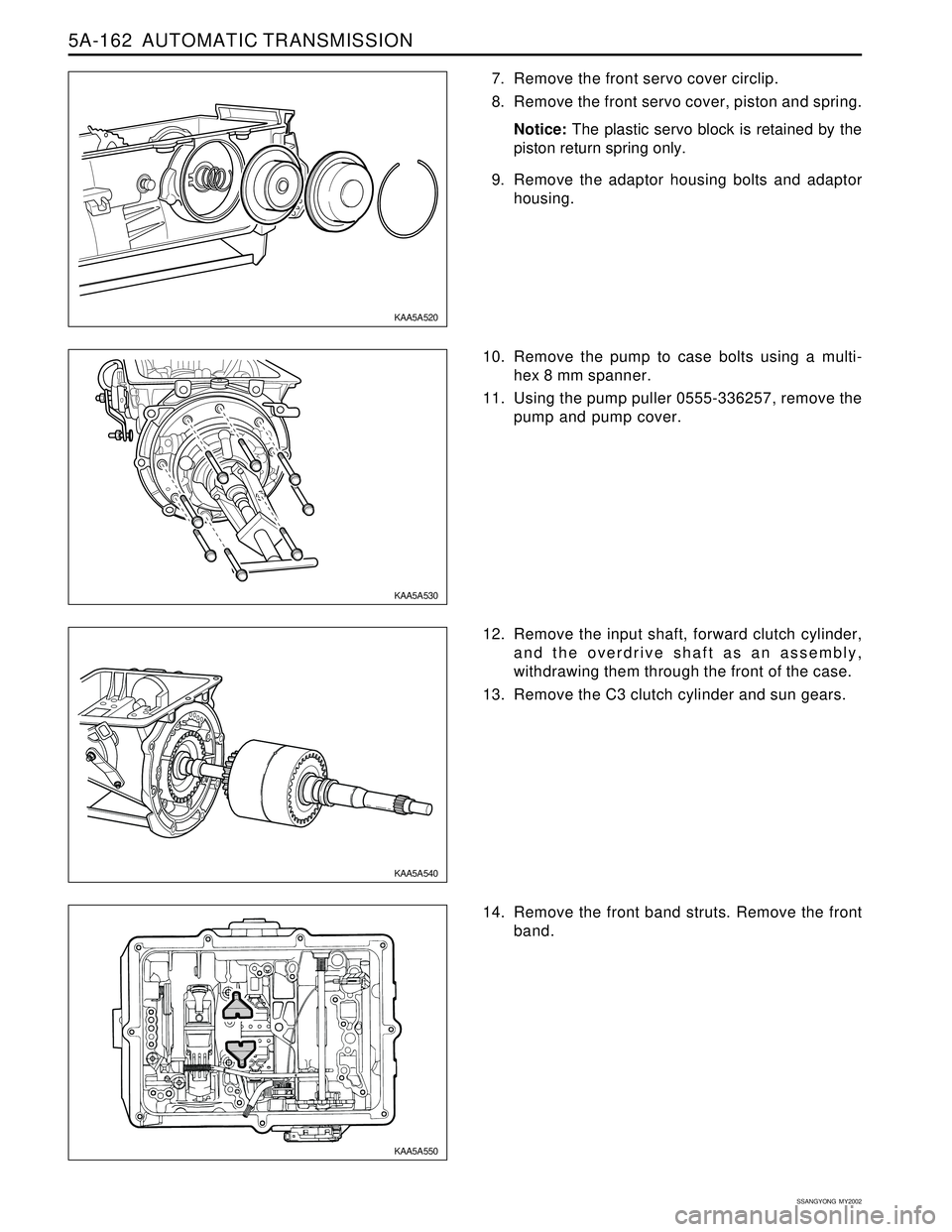
5A-162 AUTOMATIC TRANSMISSION
SSANGYONG MY2002
7. Remove the front servo cover circlip.
8. Remove the front servo cover, piston and spring.
Notice: The plastic servo block is retained by the
piston return spring only.
9. Remove the adaptor housing bolts and adaptor
housing.
10. Remove the pump to case bolts using a multi-
hex 8 mm spanner.
11. Using the pump puller 0555-336257, remove the
pump and pump cover.
12. Remove the input shaft, forward clutch cylinder,
and the overdrive shaft as an assembly,
withdrawing them through the front of the case.
13. Remove the C3 clutch cylinder and sun gears.
14. Remove the front band struts. Remove the front
band.
KAA5A520
KAA5A530
KAA5A550 KAA5A540
Page 1261 of 2053
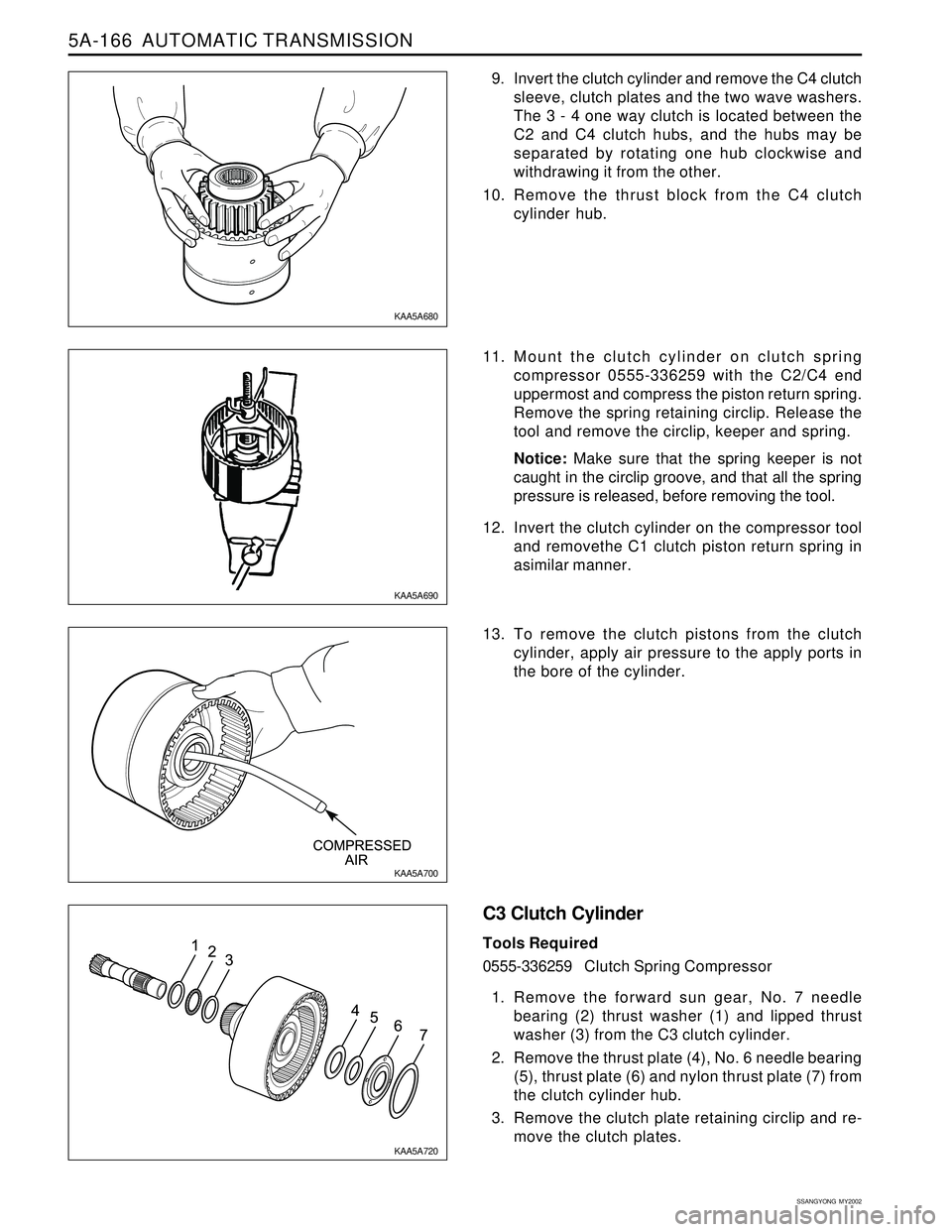
5A-166 AUTOMATIC TRANSMISSION
SSANGYONG MY2002
9. Invert the clutch cylinder and remove the C4 clutch
sleeve, clutch plates and the two wave washers.
The 3 - 4 one way clutch is located between the
C2 and C4 clutch hubs, and the hubs may be
separated by rotating one hub clockwise and
withdrawing it from the other.
10. Remove the thrust block from the C4 clutch
cylinder hub.
11. Mount the clutch cylinder on clutch spring
compressor 0555-336259 with the C2/C4 end
uppermost and compress the piston return spring.
Remove the spring retaining circlip. Release the
tool and remove the circlip, keeper and spring.
Notice: Make sure that the spring keeper is not
caught in the circlip groove, and that all the spring
pressure is released, before removing the tool.
12. Invert the clutch cylinder on the compressor tool
and removethe C1 clutch piston return spring in
asimilar manner.
13. To remove the clutch pistons from the clutch
cylinder, apply air pressure to the apply ports in
the bore of the cylinder.
C3 Clutch Cylinder
Tools Required
0555-336259Clutch Spring Compressor
1. Remove the forward sun gear, No. 7 needle
bearing (2) thrust washer (1) and lipped thrust
washer (3) from the C3 clutch cylinder.
2. Remove the thrust plate (4), No. 6 needle bearing
(5), thrust plate (6) and nylon thrust plate (7) from
the clutch cylinder hub.
3. Remove the clutch plate retaining circlip and re-
move the clutch plates.
KAA5A680
KAA5A690
KAA5A700
KAA5A720